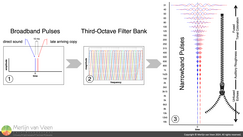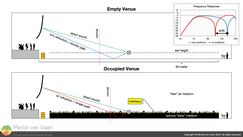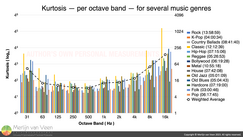
- Details
 Figure 1Audio practitioners and musicians alike are intimately familiar with slapback echoes when a snare drum's sound bounces off a specular rear wall or balcony face, a phenomenon less frequently observed with kick drum sounds. This discrepancy hints at a frequency‑dependent echo perception‑threshold.
Figure 1Audio practitioners and musicians alike are intimately familiar with slapback echoes when a snare drum's sound bounces off a specular rear wall or balcony face, a phenomenon less frequently observed with kick drum sounds. This discrepancy hints at a frequency‑dependent echo perception‑threshold.
- Details
 Figure 1Sound traveling slower through the audience than the air above it, is a well‑accepted phenomenon. And compelling supporting evidence has been published in the past decade. Nevertheless, one must always remain vigilant of the possible causes for sound getting decelerated. Is the audience to blame, or a drop in temperature, or a combination of both?
Figure 1Sound traveling slower through the audience than the air above it, is a well‑accepted phenomenon. And compelling supporting evidence has been published in the past decade. Nevertheless, one must always remain vigilant of the possible causes for sound getting decelerated. Is the audience to blame, or a drop in temperature, or a combination of both?
- Details
 Figure 1Kurtosis and crest factor are closely related. But unlike crest factor, Kurtosis is not exclusively peak‑centric. Kurtosis indicates the presence of outliers in general as well as peaks. For music, kurtosis is a function of frequency (Figure 1).
Figure 1Kurtosis and crest factor are closely related. But unlike crest factor, Kurtosis is not exclusively peak‑centric. Kurtosis indicates the presence of outliers in general as well as peaks. For music, kurtosis is a function of frequency (Figure 1).
Regrettably, in order to appreciate this, some math is inevitable.
- Details
 Bill WhitlockDisturbance signals, such as hum, buzz, or noise, can be extremely frustrating. And troubleshooting them is oftentimes a time‑intensive process of trial and error. Until I learned of Bill Whitlock and his education[1] on Audio System Grounding and Interfacing.
Bill WhitlockDisturbance signals, such as hum, buzz, or noise, can be extremely frustrating. And troubleshooting them is oftentimes a time‑intensive process of trial and error. Until I learned of Bill Whitlock and his education[1] on Audio System Grounding and Interfacing.
Whitlock recommends relatively simple means to — methodologically — identify causes for disturbance signals. And while his teachings have always appealed to me, I never got to the point of actually building some of the tools myself. Until recently.
- Details
Why do certain channels on a mixing console featuring transient signals (like drums) run hotter than other channels (e.g., strings) even though they all sound equally loud? Let us look at duty cycles.